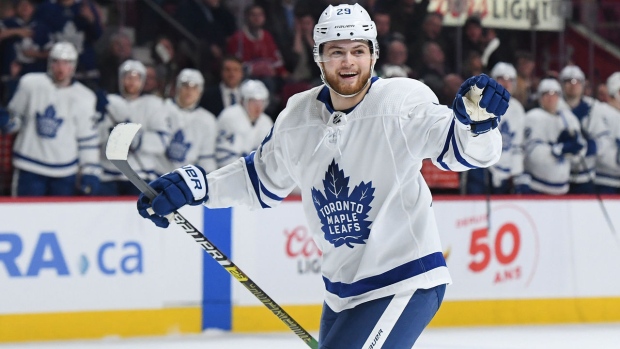Apr 27, 2020
The evolution of William Nylander
Toronto Maple Leafs forward was having a breakout season, thanks to a combination of opportunity and improved linemates, Travis Yost writes.
By Travis Yost

Look around the National Hockey League, and you can find a couple of players in every organization who might be deprived of finishing exceptional seasons because of the coronavirus outbreak.
In Toronto, no player had a bigger year than 22-year-old Auston Matthews, who was in the heat of the Rocket Richard race with Boston’s David Pastrnak and Washington’s Alexander Ovechkin.
Matthews has been a superstar since the minute he entered the league, and this year solidified his position as one of the league’s premier offensive weapons. (It’s a shame we might not get to see the end of this prediction.)
Lost in Matthews’ season was a breakout year by his 23-year-old teammate William Nylander. Despite similar accolades prior to entering the league, Nylander has travelled a much rockier road, one seeped with questions about his ability to consistently score against NHL-calibre defences.
Let’s also not forget his rather acrimonious contract negotiation with the Maple Leafs organization, one that was resolved by way of a last-minute deal during the 2018-29 regular season.
Nylander wasn’t a fully polished player entering the league, but the criticism around his game always felt a shade more aggressive than what was warranted.
In four seasons and change, Nylander has scored 87 goals in 307 games, or 0.8 goals per 60 minutes of play. That is on par with the likes of Arizona’s Taylor Hall and Calgary’s Matthew Tkachuk. Bring in his assist contributions, and Nylander moves into the top 50 in scoring league-wide over the same time frame at 2.1 points per 60 minutes. That is on par with Dallas’ Jamie Benn, and ahead of Carolina’s Andrei Svechnikov. It’s very respectable company. (He is also +40 goals at even strength, which is important considering how strong of a defensive player he is.)
A lot of his surge in the multi-year scoring race came from this season, where Nylander potted 31 goals and 28 assists. There is no shortage of explanations for Nylander’s outburst, but near the top of list is a combination of opportunity and improved linemates. Just look at how his common linemates have progressed over the years, starting in 2015-16. It’s night and day.

The last two years have been much more kind on the teammate quality front, but you have to take Nylander’s shortened 2018-19 season with a grain of salt – he didn’t even log his first game that year until Dec. 6, injected into the lineup as the ink was drying on his contract. (There’s no question that some of that is on Nylander, who chose to negotiate his contract through the season.)
But this season was a different animal, in part because Nylander was always playing with an elite centre. If you look at the raw data, you see that Nylander played about 56 per cent of his even-strength minutes with Matthews and 41 per cent with John Tavares. The key distinction here is that Matthews and Tavares rarely played together (10 per cent of their minutes together), which means that Nylander always had one of the two on his hip.
I bring that up because one thing that we know about both Matthews and Tavares is that they are elite individual shooters and play creators, both of which can benefit a winger as talented as Nylander.
Nylander has had some roller-coaster shooting percentages over the years, but one thing is true: as his game has become more refined, his coaches have been more comfortable locking him into a top-six role.
A top-six role comes with better supporting talent. And what a surprise, Nylander has become a consistently more threatening shooter. Look just at his expected scoring rates for confirmation of that:

There’s one other important plot that shows how strong of a rebound Nylander has had this year, and that concerns where his shots are coming from. The beauty of playing with a centre like Matthews or Tavares is they are going to be good at finding passing lanes others can’t; they’ll also create heaps of rush and rebound opportunities for wingers who can effectively crash the net, or finesse their way around slower defenders. Nylander can do both.
Consider his year-over-year shot maps for a moment. We figured last year was something of an albatross season – whether it was the late start, the ever-changing linemates, or an inability to finish on scoring opportunities, it was underwhelming.
How do you turn it around? Shoot from the premier scoring areas, and do so with a high degree of frequency (via Evolving Hockey; note 12 additional games played year over year):

Though we may not be able to see how Nylander would have finished the season, this is exactly what general manager Kyle Dubas and the Toronto Maple Leafs envisioned for the growth of his game. Nylander’s evolution took a handful of seasons, and the team is materially better with him on the ice.
If it’s a sign of things to come, the contract we spent months analyzing will start to look very team friendly in a hurry.
Data via Evolving Hockey and NHL.com


